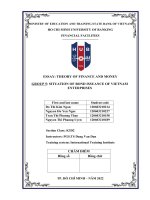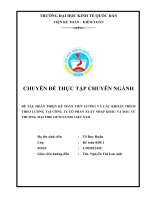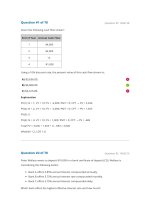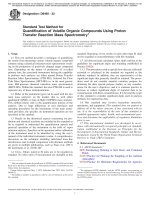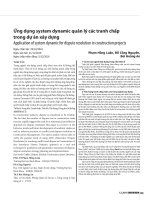Analysis Efficiency of Luwak Coffee Business
Bạn đang xem bản rút gọn của tài liệu. Xem và tải ngay bản đầy đủ của tài liệu tại đây (292.32 KB, 7 trang )
Content is available at :
/>ISSN 2621-217X (PRINT)
ISSN 2621-699X (ONLINE)
Analysis Efficiency of Luwak Coffee Business
Niken Dwinora, Eko Sumartono, Bambang Sumantri
Department of Agricultural Socio-Economics, Faculty of Agriculture University of Bengkulu
Email:
ABSTRACT : The purposes of this study were to 1) Calculate the amount of profit from the civet coffee
processing business in Bandung Jaya Village, Kabawetan District, Kepahiang Regency. 2) To calculate the
efficiency of the civet coffee business in Bandung Jaya Village, Kabawetan Subdistrict, Kepahiang Regency,
with consideration that in Bandung jaya Village, Kabawetan Subdistrict, Kepahiang Regency has the most
sought after sales of civet coffee. Sampling was done by using the Purposive Method. Because the
researchers intentionally took the data in the Luwak Coffee business stamp well in Bandung Jaya Village,
Kabawetan District, Kepahiang District, the data analysis used the R / C ratio and B / C methods. The
results showed that the efficiency analysis of R / C Ratio showed that Luwak coffee business was very
efficient because revenues were greater than the total production costs. The results of the B / C Ratio
analysis showed that these business ws not feasible because income is lower than the total production cost.
Keywords: Luwak Coffee; efficiency; civet coffee business;
Citation to this paper should be made as follows :
Dwinora, N. Sumartono, E. Sumantri, B. 2018. Analysis Efficiency Of Luwak Coffee Business. Agritropica:
Journal of Agricultural Science. 1 (2): 78-84. DOI: />
INTRODUCTION
Indonesia is an agricultural country that
has fertile land and is a very strategic field in
agriculture because it is related to human
labor. The agricultural sector is a necessity
that’s important both from food, feed and the
board. The agricultural sector, especially the
food sector, is the highest income producer in
Indonesia which will increase the economy
which will lead to good welfare.
The development of the food processing
industry in Indonesia, which is supported by
agricultural natural resources, both vegetable
and animal that are able to produce various
processed products that can be made and
developed from local or regional natural
resources. At present in several Asian countries
many food products are raised from local food
types and processed traditionally. With the
development of these local products, the
number and type of food products are
increasing in number (Soleh, 2003).
According to Widianti, E (2010), this
small-scale industrial business that has
developed in Indonesia is in the food sector.
According to Wirakartakusumah (1997), one of
the most important sectors whose role is the
food industry will increase the Indonesian
economy. Because it is able to meet the needs of
food in Indonesia, the food industry is also able
to increase foreign exchange. And the
emergence of labor is needed to assist in
managing the industry in the food sector which
will encourage the advancement of an industry
from year to year. Can also meet supporting
needs such as food additives industry,
packaging industry, machinery industry and
food processing equipment and agribusiness
industry.
Processing coffee fruit into coffee
powder is an action that will add economic
value in it which usually only earns a little
income by converting coffee beans into coffee
powder, so the economic value is there. And
materials that are easily compacted.
The potential of coffee beans owned
in Kabawetan district does exist. With the
existence of a home industry that manages
various kinds of processed coffee beans into
several types. Such as red coffee powder,
orijinal coffee bean powder, Robusta coffee
78 | Dwinora et al : Analysis efficiency of luwak coffee business
powder, Arabica coffee powder and the most
famous and tastes good at an expensive price,
namely civet coffee powder. They also sell
coffee beans that are unruly black. It is these
unripe seeds that are ground into coffee
powder.
Processing is carried out by the
community, especially the people of Kepahiang
regency who process red coffee beans to be
used as civet coffee beans by giving red coffee
beans as mongoose food. Their mongoose is
obtained from farmers who catch Lusang on
their land. Farmed mongoose is a nuisance
animal. But in farmers who manage civet
coffee, mongoose is an animal that is very
useful for the fermentation process of red
coffee, especially Arabica coffee. Mongoose
coffee beans are indeed released from a very
disgusting process, but because the taste is very
good, it makes people not see the process again,
but they prefer to taste the taste that is very
delicious from civet coffee.
Taking into account the preferences of
consumers for civet coffee, so many of our
farmers run this business. Increase the amount
of production and it is likely that the benefits
will be greater as well.
In any other business, the home
industry of an individual generally has the
nature of confidentiality over the financial
statements or all information relating to the
business financial problems that he is currently
living, with reasons that are as diverse as so
that they cannot be utilized by other business
people. Because of this, there are many
individual home industry owners who feel they
don't need to make financial reports and their
analysis. Even though this report is very
necessary. Because we can know whether it is
worthy or not worthy of this effort. Because of
that revenue and income, we can usually see
whether the business is efficient or not. With a
financial report book, efficient business can be
measured.
This condition also causes the sole
owner of an individual civet coffee business to
not be able to monitor the health condition of
the company from time to time and this causes
the owner not to have a strong foundation in
making strategies in marketing their products.
It will even be very dangerous when the
individual business owner does not realize that
his company is heading for bankruptcy.
So from that it is necessary to analyze
a business efficiency that will lead to a clearer
advantage in an enterprise if this business does
work well with good or no benefits at all
(Suryanto et al, 2016).
The purpose of this study is to
calculated the amount of profit from the civet
coffee processing business in Bandung Jaya
Village, Kabawetan District, Kepahiang
Regency and to calculate the efficiency of the
civet coffee business in Bandung Jaya Village,
Kabawetan District, Kepahiang District.
RESEARCH METHODS
Location and Time of Research
The location is the focus of this field
lecture done purposively, namely the civet
coffee processing business
located in
Kabawetan district, Kepahiang Regency. The
researcher chose this location with the
consideration that in this district there was a
household business belonging to "Bapak
Suwandi" which was classified as a home
industry that processed the civet coffee
business and had been visited by many
consumers. This research was conducted in
November 2017.
Sample Determination Method
In this study, the researcher used the
purposive method. Because intentionally or
directly making a good civet coffee business is
used as a respondent in the Luwak Cap Home
industry business which produces processed
Luwak Coffee located in Bandung Jaya Village,
Kabawetan District, Kepahiang Regency.
Data Analysis Method
1. Business Efficiency Analysis
a. Rentrun / Cost ratio (R / C ratio) is a
comparison value between the total revenue of
Luwak coffee business and the total cost of
civet coffee for one year.
a. Cost
The total cost is the sum of the fixed
costs and variable costs of the civet coffee
business in Bandung Jaya Village, Kabawetan
District, Kepahiang District. Cost has a formula
(Soekartawi 2002):
TC = FC + VC
Information:
Agritropica : Journal of agricultural science, Volume 1, Number 2, Page 78 - 84 | 79
TC = total cost (total cost)
FC = fixed cost (fixed coost)
VC = variable cost (variable cost)
b. Income
Income is the money value of the total
product or the product of the multiplication of
total production and the price of production.
Income analysis formula (Soekartawi, 2002):
Pd = TR - TC
TR = Y. Py
Information:
Pd = income of civet coffee business
TR = total revenue (total revenue)
TC = total cost (total cost)
TR = total revenue (total revenue)
Y = production obtained in a civet coffee
business
Py = price Y
Business efficiency is a measure to see
the success of a civet coffee business that can
be assessed in terms of the amount of cost to
achieve a business that is more developed and
can run well in the future. Efficiency
measurement can be seen from, if R / C> 1
then we can say efficient and if R / C <1 then it
is not efficient or it needs to be unfeasible to
develop (soekartawi, 2002). Business efficiency
formula:
a=R/C
Information:
a = R / C ratio
R = acceptance
C = cost (cost)
The criteria:
1. If R / C> 1, then it is profitable or
feasible business to continue in the next
period
2. If the R / C <1 does not impinge or the
business is not feasible to continue
Benefit / Cost Ratio (B / C Ratio)
Is the ratio of the total present value of
benefits and costs. A viable alternative
criterion is a B / C ratio greater than 1 and an
alternative that has the highest B / C Ratio at
the first level (Wijaya et al. 2011). B / C Ratio
are a measure of the comparison between
income (benefit) and the total cost of
production (Cost), with the formula:
B / C Ratio = (Total Revenue) /
(Total Production Cost)
Criteria:
1. B / C Ratio> 1: profitable or feasible
business carried out
2. B / C Ratio <1: Not profitable or
business is not feasible
RESULTS AND DISCUSSION
Technical and Production Aspects
Business Location
The location of the civet coffee business
"Mr. Suwandi" is located in Bandung Jaya
Village, Kabawetan District, Kepahiang
Regency, Bengkulu City. Location of civet
coffee business is close to residential areas.
This is what supports many people or
consumers easily in buying a copy of the
mongoose "Mr. Suwandi" plus the mongoose
coffee business is easy in finding sources of
raw materials. Both from the coffee raw
material it self and mongoose animals to
produce civet coffee beans.
The mongoose animal is placed in a
cage next to the house "Mr. Suwandi".
Therefore from the process of taking civet
seeds closer. Even drying is close to the cage
because of the cage and drying place beside the
house of Mr. Suwandi himself because there is
an empty land next to the house "Mr. Suwandi"
which is specifically for the process of drying
civet coffee.
Production facilities and equipment
Production facilities and equipment
owned by the Luwak coffee business “Mr.
Suwandi” includes:
1. Cage
The cage used is 4x5 meters with an
economic life of around 10 years. The cage in
the form of a house made of concrete and roof
tile. Inside is an iron bar. There are 16 iron
barriers in the cage. Used to separate the
mongoose owned by "Mr. Suwandi". In one
skate iron in the cage there are 2-3 mongooses.
The floor is cement and there are a few tree
branches
for
mongoose
playgrounds.
Sometimes is placed fruits to eat mongoose.
2. Equipment
The equipment and equipment used in
the Luwak coffee business are roasting
machines (frying machines), fresh machines,
huller machines, coffee pounding machines,
80 | Dwinora et al : Analysis efficiency of luwak coffee business
large scales, electric scales, small scales,
medium scales.
Bandung Jaya Village, Kabawetan District,
Kepahiang Regency are as follows:
3. Feed
Table 1. Fixed costs of luwak coffee business
in Bandung Jaya Village, Kabawetan
District, Kepahiang Regency
The feed given to Luwak is usually in
the form of papaya, milk, and chicken head.
For food, it is given in the morning and
evening. Milk is given twice a month as much
as 20 liters. While the chicken head is given
once a month as much as 3 kg.
Marketing Aspect
Marketing in a business is an absolute
thing that must be done or a main activity
other than production which is useful to
maintain the continuity of its business and get
a profit (profit). The marketing channels
carried out by this business are quite modern
because many are ordering orders for civet
coffee online and as for those who come
directly to the civet coffee business in Bandung
Jaya village.
Aspects of Business Costs of Civet Coffee
Luwak coffee production process is
carried out for one week. As long as the
production costs quite a lot in this civet coffee,
starting from mongoose feed, equipment,
labor, and other production facilities. The costs
incurred by Mr. Suwandi consist of fixed costs
and variable costs.
Marketing Aspect
Marketing in a business is an absolute
thing that must be done or a main activity
other than production which is useful to
maintain the continuity of its business and get
a profit (profit). The marketing channels
carried out by this business are quite modern
because many are ordering orders for civet
coffee online and as for those who come
directly to the civet coffee business in Bandung
Jaya village.
Fixed cost
Fixed costs are costs incurred by
Luwandi Mr. Suwandi's coffee business in
Bandung Jaya Village, Kabawetan district,
Kepahiang Regency for a business year whose
size is not directly related to the amount of
production issued by Luwak coffee business
during the civet coffee business. The fixed costs
incurred by the civet coffee business in
Percent
(%)
No
Description
IDR
1
Equipment
Depreciation
Costs
Labor Costs
Total
15,923,333.33
44.91
19,530,000.00
35,453,333.33
55.09
100
2
Source: Primary Data Processed (2018)
Based on table 1 above, the total fixed
costs incurred by Mr. Suwandi in his civet
coffee business for one year are IDR.
35,453,333.33 / year. These costs consist of
depreciation costs and labor costs. The total
depreciation cost of the tool is IDR.
15,923,333.33 / year or with 44.91% percent of
fixed costs, while labor costs amounting to
IDR. 19,530,000.00 / year or with 55.09%
percent.
Variable Costs
Variable costs of civet coffee business
are costs incurred for purposes for one
business year and the amount is influenced by
the amount of production produced. The
average cost spent every year is IDR.
22,911,000 / year. These costs can be seen in
the table below:
From table 2 above, it can be seen that
the total variable costs incurred during the
one-year period in Mr. Suwandi's Luwak
coffee business in Bandung Jaya Village,
Kabawetan District, Kepahiang Regency are
IDR. 22,911,000 / year. Of the total costs that
exist in the variable cost component, the cost of
feed is the greatest by spending a fee of IDR.
5,160,000 / year. The biggest feed cost is
because the feed given to the civet is many
variants so that mongoose is not bored in
eating coffee fruit only. As well as mongoose
nutrition must also be made so that the
mongoose survives while producing civet
coffee. The second largest component is
packaging fuel with an amount of IDR.
5,000,000 / year, the raw material for civet
coffee uses arabica coffee with an amount of
Agritropica : Journal of agricultural science, Volume 1, Number 2, Page 78 - 84 | 81
IDR. 9,650,000 / year, while the smallest cost is
in fuel costs with an amount of IDR.. 3,101,000
/ year.
Acceptance
The receipt of Mr. Suwandi's Luwak
coffee business comes from the receipt of sold
civet coffee with the value of cash received by
Mr. Suwandi for the sale of civet coffee.
Acceptance of Mr. Suwandi Luwak coffee
business in Bandung Jaya Village, Kabawetan
Subdistrict, Kepahiang Regency for one year
was IDR. 255.00,000 / year.
Table 2. Variable costs of luwak coffee business in Bandung Jaya Village, Kabawetan District,
Kepahiang Regency
No
Description
Feed
Papaya
Milk
Chicken head
Fuel
2
Gasoline Liter
Liter Oil
Packaging Materials
3
Black Aluminum Seed
Seed Stickers
Raw Material Costs
4
Arabica Coffee
Total Variable Cost
Unit
Total/ year
IDR/year
Percent (%)
1
Kg
Kg
Kg
900
240
36
2.700.000
1.920.000
540.000
12
8
2
Liter
Liter
252
31
2.016.000
1.085.000
9
5
Biji
Biji
2000
2000
3.000.000
2.000.000
13
9
Kg
1900
Source: Primary Data Processed (2018)
Table 3. Total revenue of luwak coffee business
in Bandung Jaya Village, Kabawetan
District, Kepahiang Regency
No.
Production of Luwak Powder Coffee
Month
1
Amount (Kg)
Price
(Rp)
Total (Rp /
Kg)
35
600.000
21.000.000
40
600.000
24.000.000
38
600.000
22.800.000
January March
2
April June
3
July September
4
OctoberDecember
Total / year
57
600.000
34.200.000
170
2.400.000
102.000.000
Average / year
42,5
600.000
255.00.000
Source: Primary Data Processed (2018)
Based on the data in table 4 above, it
can be seen that the income obtained by Mr.
Suwandi's Luwak coffee business is IDR.
21,000,000 for January-March. For April-June
IDR. 24,000,000. While the July-September
number is IDR. 22,800,000 and for OctoberDecember the amount is IDR. 34,000,000. this
month was the biggest acceptance received by
9.650.000
42
22.911.000
100
Luwandi Mr. Luwak's coffee business, because
this month many consumers ordered civet
coffee into Mr. Suwakdi. Due to being close to
Christmas and New Year's Day. And for this
month expenditure is not too large compared
to other months because in other months
consumers have more expenditure due to
school holidays, fasting month and Eid.
Income
Luwandi Mr. Luwan's coffee business
income is obtained from the calculation of the
total revenue minus the total production costs.
Where will generate income that will be used
as a benchmark whether Mr. Suwandi's
business has been profitable or lost. The
income of Luwan Mr. Suandi's coffee business
can be seen from the following table:
Table 3. Business income of luwak coffee Mr.
Suwandi in Bandung Jaya Village,
Kabawetan District, Kepahiang Regency
No
Description
IDR / Year
1
Total Revenue
105,000,000
2
Total Production Costs
58,364,333.33
Income
46,635,667
Source:
Primary
Data
Processed
(2018)
82 | Dwinora et al : Analysis efficiency of luwak coffee business
From the data in table 5 above, we can
see that the income of Mr. Suwandi’s Luwak
coffee is IDR. 46,635,667/ year. Where the total
revenue is IDR. 105,000,000 / year is reduced
by the total production costs at a cost of IDR.
58,364,333.33 / year. Then we can conclude
that the income that Mr. Suwandi has is very
large or profitable.
Efficiency Analysis
R / C Ratio Analysis
Business efficiency analysis shows the
calculation of R / C Ratio with the results
obtained at 1.8. This value is obtained from the
receipt of IDR. 102,000,000 / year, divided by
the total production costs at a cost of IDR.
58,364,333.33 / year and the result is 1.8 or> 1,
meaning that Mr. Suwandi's Luwak coffee
business can be declared as a business that is in
the "Efficient" category. The figure shows that
in every Rp.1 cost incurred by Mr. Suwandi in
his civet coffee business, a net income of IDR.
1.8.
B / C Ratio Analysis
Benefit Cost Ratio is a comparison of
the amount of the present value of the benefits
and expenses of the coffee industry business
during its economic life. This ratio or
comparison must be greater than 1. The greater
the difference between 1, the smaller the
project risk / industrial business or investment
risk (investment risk) (Sulianti, I and Lina F.T,
2013).
According to Tirta, P.W.W.K (2012) if
the value of B / C ratio is greater than one, the
project / industrial business is declared
feasible. Then if the B / C ratio is equal to one
then the project is called break even, whereas if
the B / C ratio is smaller than one then the
project or industry is declared loss.
The business feasibility analysis shows
the calculation of B / C Ratio with the results
obtained at 0.8. This value is obtained from the
income of IDR. 46,635,667 / year, divided by
the total production costs at a cost of IDR.
58,364,333.33 / year and the result is 0.8 or <1,
meaning that Mr. Suwandi's Luwak coffee
business can be declared as a business that falls
into the category of "not feasible or loss". The
figure shows that in every Rp.1 cost incurred
by Pak Suwandi in his civet coffee business, a
net income of IDR. 0.8.
CONCLUSION AND RECOMMENDATION
Conclusion
Based on the results of the analysis and
discussion, a number of conclusions can be
drawn from the Luwandi Luwak coffee
business worthy of being developed. It can be
seen that the total production costs with a
value of IDR. 58,364,333.33 / year while the
income earned is IDR. 289,635,667 / year.
In the calculation of the R / C ratio with
the results obtained at 1.8. This value is
obtained from the receipt of IDR. 102,000,000 /
year, divided by the total production costs at a
cost of IDR. 58,364,333.33 / year and the result
is 1.8 or> 1, meaning that Pak Suwandi's
Luwak coffee business can be declared as a
business that is in the "Efficient" category. And
from the calculation of B / C Ratio, it can be
seen that Luwak Luwak coffee business is not
profitable. With an income of IDR. 46,635,667 /
year, divided by the total production costs at a
cost of IDR. 58,364,333.33 / year and the result
is 0.8 or <1, meaning that Mr. Suwandi's
Luwak coffee business can be declared as a
business that falls into the category of "not
feasible or loss".
Recommendation
• To business owners to better market civet
coffee outside Sumatra. If you can, go abroad
to get more income than before. And for the
production process, it is expected to maintain
cleanliness. Use gloves so that when filling in
the coffee into the coffee package, the result
will be more hygienic.
• To owners more minimize costs, both
variable and fixed costs. In order to get a
bigger income.
• For the government so that small-scale
businesses or small-scale micro-businesses can
develop more and develop this business so that
they are always progressing and do not arrive
at bankruptcy.
REFERENCES
Soekartawi. 2002. Ilmu usaha tani dan peneliti
untuk pengembangan petani kecil.
Universitas indonesia Press. Jakarta
__________2003.
Agribisnis
Teori
dan
Aplikasinya. Raja Grafindo Persada.
Jakarta.
Agritropica : Journal of agricultural science, Volume 1, Number 2, Page 78 - 84 | 83
Soleh, M. 2003. Perbaikan Mutu dan Keamanan
Pangan Produk Olahan Hasil Industri
Kecil Melalui Analisa Bahaya dan
Penentuan Titik Kendali. Dalam Buletin
Teknologi dan Informasi Pertanian. vol 6.
Departemen Pertanian Badan Penelitian
dan Pengembangan Pertanian(BPTP).
Jawa Timur.
Sulianti, I, dan Lina Flaviana Tilik. 2013.
Analisis Kelayakan Finansial Internal
Rate of Return (IRR) dan Benefit Cost
Ratio (BCR) pada Alternatif Besaran
Teknis
Bangunan
Pasar
Cinde
Palembang. Jurnal Polsri. 8(1):834-835
Tirta , P.W.W.K. 2012.Kanalisis Kelayakan
Finansial Pengembangan Usaha Kecil
Menengah (Ukm) Nata De Coco Di
Sumedang, Jawa Barat. Jurnal Inovasi
Dan Kewirausahaan. 1(2):117-118
Widianti, Erlin. 2010. Analisis Usaha Kerupuk
Pathilo Skala Rumah Tangga Di
Kabupaten Wonogiri. Fakultas Pertanian
Universitas Sebelas Maret Surakarta
(Skripsi) sudah di publikasi. Diakses
06 Juni 2017.
Wijaya,
S.S, Anhar Solichin, dan Dian
Wijayanto2 dan Faik Kurohman2.
2011. Produktivitas Dan Kelayakan
Usaha Tuna Longliner Di Kabupaten
Cilacap Jawa Tengah.Jurnal Saintek
Perikanan. 6(2), 2011
Wirakartakusumah, M. A. 1997. Telaah
Perkembangan Industri Pangan di
Indonesia Dalam Jurnal Pangan . 8(32).
Penerbit Bulog. Jakarta.
84 | Dwinora et al : Analysis efficiency of luwak coffee business
